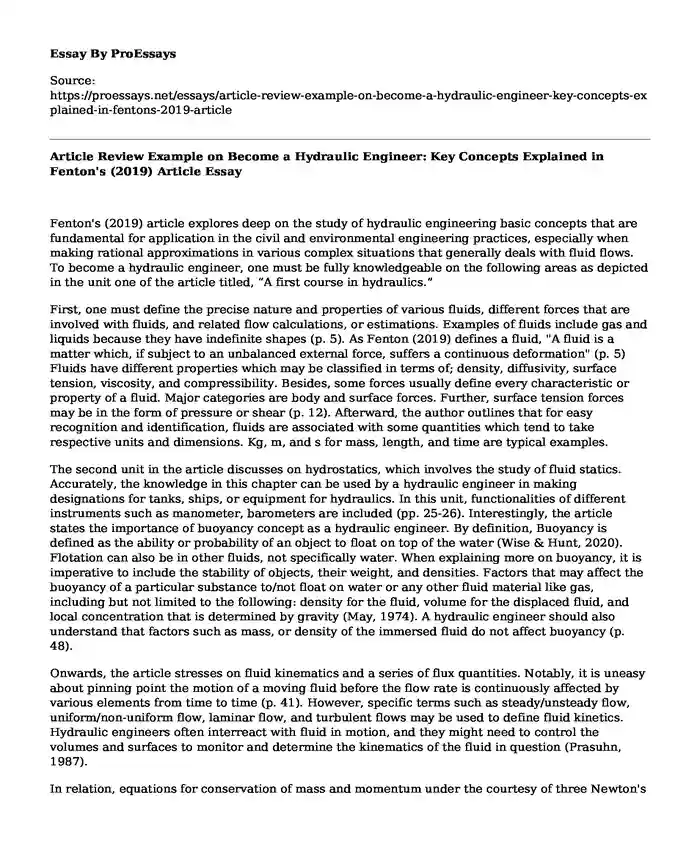Fenton's (2019) article explores deep on the study of hydraulic engineering basic concepts that are fundamental for application in the civil and environmental engineering practices, especially when making rational approximations in various complex situations that generally deals with fluid flows. To become a hydraulic engineer, one must be fully knowledgeable on the following areas as depicted in the unit one of the article titled, “A first course in hydraulics.”
First, one must define the precise nature and properties of various fluids, different forces that are involved with fluids, and related flow calculations, or estimations. Examples of fluids include gas and liquids because they have indefinite shapes (p. 5). As Fenton (2019) defines a fluid, "A fluid is a matter which, if subject to an unbalanced external force, suffers a continuous deformation" (p. 5) Fluids have different properties which may be classified in terms of; density, diffusivity, surface tension, viscosity, and compressibility. Besides, some forces usually define every characteristic or property of a fluid. Major categories are body and surface forces. Further, surface tension forces may be in the form of pressure or shear (p. 12). Afterward, the author outlines that for easy recognition and identification, fluids are associated with some quantities which tend to take respective units and dimensions. Kg, m, and s for mass, length, and time are typical examples.
The second unit in the article discusses on hydrostatics, which involves the study of fluid statics. Accurately, the knowledge in this chapter can be used by a hydraulic engineer in making designations for tanks, ships, or equipment for hydraulics. In this unit, functionalities of different instruments such as manometer, barometers are included (pp. 25-26). Interestingly, the article states the importance of buoyancy concept as a hydraulic engineer. By definition, Buoyancy is defined as the ability or probability of an object to float on top of the water (Wise & Hunt, 2020). Flotation can also be in other fluids, not specifically water. When explaining more on buoyancy, it is imperative to include the stability of objects, their weight, and densities. Factors that may affect the buoyancy of a particular substance to/not float on water or any other fluid material like gas, including but not limited to the following: density for the fluid, volume for the displaced fluid, and local concentration that is determined by gravity (May, 1974). A hydraulic engineer should also understand that factors such as mass, or density of the immersed fluid do not affect buoyancy (p. 48).
Onwards, the article stresses on fluid kinematics and a series of flux quantities. Notably, it is uneasy about pinning point the motion of a moving fluid before the flow rate is continuously affected by various elements from time to time (p. 41). However, specific terms such as steady/unsteady flow, uniform/non-uniform flow, laminar flow, and turbulent flows may be used to define fluid kinetics. Hydraulic engineers often interreact with fluid in motion, and they might need to control the volumes and surfaces to monitor and determine the kinematics of the fluid in question (Prasuhn, 1987).
In relation, equations for conservation of mass and momentum under the courtesy of three Newton's laws of motion are highlighted. The primary importance of these three laws is that a hydraulic engineer can easily understand, predict, and calculate the speed of moving fluids (Mahajan, 2020). Crocco’s and Bernoulli's laws are also crucial in the field of hydraulic engineering. Finally, the article studies the elements of dimensional analysis. To do so, the Buckingham II theorem is extensively applied by hydraulic engineers, while faced by calculations with an unknown number of quantities, and alongside dimensions (Finnemore & Franzini, 2002).
Conclusion
In summary, Fenton's (2019) articles depict all the necessary field requirements that a hydraulic engineer needs to be well acquainted with. The principle concepts, ideas, and integrated theories throughout the article make it suitable for the application, as one can quickly gain the concept of the study of fluids, forces, and speed of fluids in motion.
References
Fenton, J. D. (2019). A First Course in Hydraulics. http://johndfenton.com/Lectures/Hydraulics/Hydraulics.pdf
Finnemore, E. J., & Franzini, J. B. (2002). Fluid mechanics with engineering applications (Vol. 10, p. 707). New York: McGraw-Hill. https://mediacapon.pythonanywhere.com/01-max-smitham/VwLh2LQ4IH7d-fluid-mechanics-with-engineering-applications-te-9781259002274.pdf
Mahajan, S. (2020). A Student's Guide to Newton's Laws of Motion. Cambridge University Press. https://books.google.com/books?hl=en&lr=&id=jHzUDwAAQBAJ&oi=fnd&pg=PR9&dq=importance+of+newton%27s+laws+of+motion&ots=ANySaVG26A&sig=Q9rWP5SCbLvYUg4zSRrQotEzcZY
May, R. C. (1974). Factors affecting buoyancy in the eggs of Bairdiella icistia (Pisces: Sciaenidae). Marine Biology, 28(1), 55-59. https://link.springer.com/article/10.1007/BF00389117
Prasuhn, A. L. (1987). Fundamentals of hydraulic engineering. https://www.osti.gov/biblio/5521750
Wise, N. H., & Hunt, G. R. (2020). Buoyancy-driven unbalanced exchange flow through a horizontal opening. Journal of Fluid Mechanics, 888. https://www.cambridge.org/core/journals/journal-of-fluid-mechanics/article/buoyancydriven-unbalanced-exchange-flow-through-a-horizontal-opening/AC7BEE1CDFB6513153E2CCB700669BE0
Cite this page
Article Review Example on Become a Hydraulic Engineer: Key Concepts Explained in Fenton's (2019) Article. (2023, Sep 17). Retrieved from https://proessays.net/essays/article-review-example-on-become-a-hydraulic-engineer-key-concepts-explained-in-fentons-2019-article
If you are the original author of this essay and no longer wish to have it published on the ProEssays website, please click below to request its removal:
- Report Example on Counterfeit Machinery Components
- Heat Pipe Working Principles Essay
- How to Operate a Mini Excavator Paper Example
- Collaborating Successfully With Engineers - Essay Sample
- The Engineering and Construction Career Path: Where to Begin?
- Essay Example on the Path to My Academic Growth: Engineering & Management
- Free Essay Example on Social Engineering and how it applies to Coronavirus Pandemic







